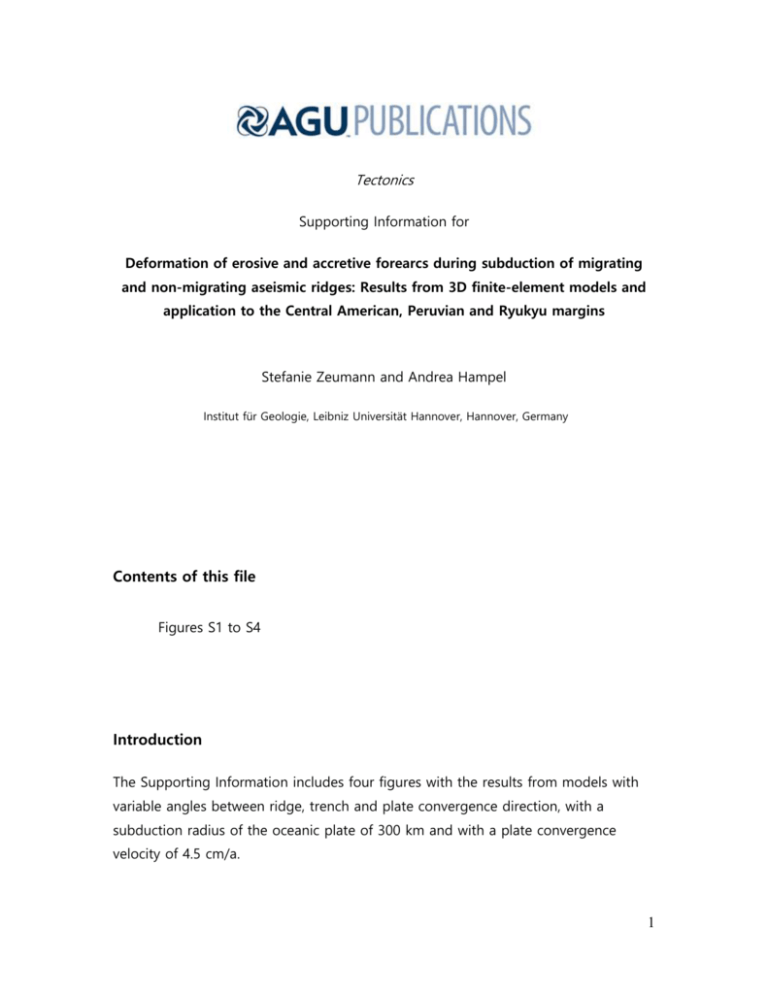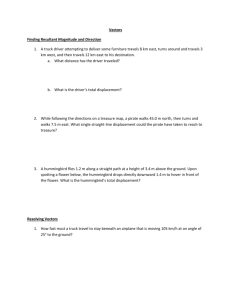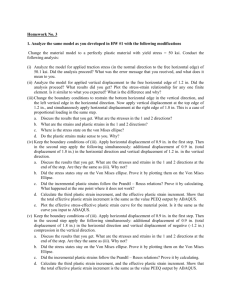tect20312-sup-0001-Supplementary
advertisement

Tectonics Supporting Information for Deformation of erosive and accretive forearcs during subduction of migrating and non-migrating aseismic ridges: Results from 3D finite-element models and application to the Central American, Peruvian and Ryukyu margins Stefanie Zeumann and Andrea Hampel Institut für Geologie, Leibniz Universität Hannover, Hannover, Germany Contents of this file Figures S1 to S4 Introduction The Supporting Information includes four figures with the results from models with variable angles between ridge, trench and plate convergence direction, with a subduction radius of the oceanic plate of 300 km and with a plate convergence velocity of 4.5 cm/a. 1 Figure S1. Displacement and strain fields (shown in top view for the central part of the forearc wedge) obtained from experiments with a non-migrating ridge and an erosive forearc. Ridge and plate convergence direction form an angle of 30° with the margin ( = = 30°). Shown are for model times of 0.5, 1 and 1.5 Ma the vertical displacement, the rate of vertical displacement (averaged over 100 ka), the total horizontal displacement (shown color-coded and by black arrows in the region above the ridge) and the total horizontal strain. Positive and negative strain values indicate shortening and extension, respectively. The horizontal displacement and strain field normal and parallel to the margin, respectively, are shown at 1.5 Ma of model time. 2 Thick white arrows indicate the plate convergence direction and dashed white lines denote the ridge position underneath the forearc. 3 Figure S2. Displacement and strain fields (shown in top view for the central part of the forearc wedge) from experiments with migrating ridges oriented oblique to an erosive forearc (cf. Figure 1c). (a) Plate convergence direction is = -60° and ridge is oriented = 60° relative to the margin. (b) = -30° and = 60°, (c) = 30° and = 60°, (d) = -30° and = 30°. Shown are at a model time of 1.5 Ma the vertical displacement, the rate of vertical displacement, the total horizontal displacement (color-coded and black arrows in the region above the ridge) and the total horizontal strain. Positive and negative strain values indicate shortening and extension, respectively. Thick white arrows indicate the plate convergence direction and dashed white lines denote the ridge position underneath the forearc. Figure S3: Displacement and strain fields (shown in top view for the central part of the forearc wedge) obtained from experiments with a radius of the oceanic plate of 300 km and a non-migrating ridge normal to an erosive forearc ( = = 90°). Shown are for model times of 0.5, 1 and 1.5 Ma the vertical displacement, the rate of vertical displacement (averaged over 100 ka), the total horizontal displacement (shown color-coded and by black arrows in the region above the ridge) and the total horizontal strain. Positive and negative strain values indicate shortening and 4 extension, respectively. Note that the total strain is derived from the largest absolute value of the principal strains (i.e. a value of -0.01 implies that the minimum principal strain at this point shows extension and has a larger absolute value than the maximum principal strain; this strain measure therefore allows differentiating between areas of net extension or shortening). The horizontal displacement and strain field normal and parallel to the margin, respectively, are shown at 1.5 Ma of model time. Except for the rate of vertical displacement, all results are shown relative to the beginning of the model run (i.e. 0 Ma model time). Thick white arrows indicate the plate convergence direction and dashed white lines denote the ridge position underneath the forearc. Figure S4: Displacement and strain fields (shown in top view for the central part of the forearc wedge) obtained from an experiment with a non-migrating ridge perpendicular to an erosive forearc ( = = 90°) and a plate convergence velocity of 4.5 cm/a. Results are shown at 1, 2 and 3 Ma of model time, i.e. at time points when the ridge has the same position underneath the forearc as in the respective experiment with 9 cm/a (Figure 2a). Shown are the vertical displacement, the rate of vertical displacement (averaged over 100 ka), the total horizontal displacement 5 (shown color-coded and by black arrows in the region above the ridge) and the total horizontal strain. Positive and negative strain values indicate shortening and extension, respectively. Note that the total strain is derived from the largest absolute value of the principal strains (i.e. a value of -0.01 implies that the minimum principal strain at this point shows extension and has a larger absolute value than the maximum principal strain; this strain measure therefore allows differentiating between areas of net extension or shortening). The horizontal displacement and strain field normal and parallel to the margin, respectively, are shown at 1.5 Ma of model time. Except for the rate of vertical displacement, all results are shown relative to the beginning of the model run (i.e. 0 Ma model time). 6





